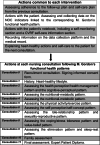Intensive nurse-led follow-up in primary care to improve self-management and compliance behaviour after myocardial infarction
- PMID: 37084014
- PMCID: PMC10333842
- DOI: 10.1002/nop2.1758
Intensive nurse-led follow-up in primary care to improve self-management and compliance behaviour after myocardial infarction
Abstract
Aims and objectives: To assess the effects of intensive follow-up by primary care nurses on cardiovascular disease self-management and compliance behaviours after myocardial infarction.
Background: Although cardiovascular disease prevention and cardiac rehabilitation take place in hospital settings, a nurse-led approach is necessary in primary care during the first few months after a myocardial infarction. Therefore, it is important to assess self-management of cardiovascular disease and levels of compliance with the prescribed diet, physical activity, and medication.
Design: The study used a multicentre, quasi-experimental, pre-post design without a control group.
Methods: Patients with acute coronary syndrome from 40 healthcare facilities were included in the study. A total of 212 patients participated in a programme including 11 interventions during the first 12-18 months after myocardial infarction. The following Nursing Outcomes Classification (NOC) outcomes were assessed at baseline and at the end of the intervention: Self-management: Cardiac Disease (1617) and Compliance Behaviour: Prescribed Diet (1622), Compliance Behaviour: Prescribed Activity (1632), and Compliance Behaviour: Prescribed Medication (1623). Marjory Gordon's functional health patterns and a self-care notebook were used in each intervention. Pre-post intervention means were compared using Student's t-tests for related samples. The results of the study are reported in compliance with the TREND Statement.
Results: A total of 132 patients completed the intervention. The indicators for each NOC outcome and the variations in scores before and after the intensive follow-up showed a statistically significant improvement (p-value = 0.000). Compliance Behaviour: Prescribed Diet (pre = 3.7; post = 4.1); Compliance Behaviour: Prescribed Activity (pre = 3.9; post = 4.3); Compliance Behaviour: Prescribed Medication (pre = 3.9; post = 4.7).
Conclusion: Intensive, immediate follow-up after myocardial infarction improves compliance behaviours and self-management of heart disease. A combined self-care and family care approach should be encouraged to empower post-myocardial infarction patients. To facilitate patients' self-efficacy, the use of health education tools such as a cardiovascular self-care notebook can also be helpful.
Relevance to clinical practice: This study highlights the benefits of intensive, protocolised, comprehensive patient follow-up in primary care during the first few months after an acute myocardial infarction (AMI). Primary care nurses train patients in cardiovascular self-care.
Patient or public contribution: Patients were not involved in either the design or the carrying out of the study. However, at the end of the study, they participated in an evaluation process about the utility of the research study and their satisfaction with it. This process was carried out using an ad hoc survey consisting of 10 questions assessing the nursing care and follow-up inputs that were received.
Keywords: aftercare; myocardial infarction; primary care nursing; self-care; self-management; treatment adherence and compliance.
© 2023 The Authors. Nursing Open published by John Wiley & Sons Ltd.
Conflict of interest statement
The authors declare no conflicts of interest to declare.
Figures
References
-
- Arrarte, V. , Campuzano, R. , de Tiedra, C. , Manjón, T. , Alarcón, J. A. , Fernández, R. , Calderón, A. , Castro, A. , Valle, A. , Meroño, O. , Obaya, J. C. , & Lasa, M. (2020). Expert consensus on the coordination of cardiac rehabilitation between cardiology departments and primary care. The RehaCtivAP project. Revista Espanola de Cardiologia Suplementos, 20, 15–21. 10.1016/S1131-3587(20)30020-0 - DOI
-
- Brotons, C. , Soriano, N. , Moral, I. , Rodrigo, M. P. , Kloppe, P. , Rodríguez, A. I. , González, M. L. , Ariño, D. , Orozco, D. , Buitrago, F. , Pepió, J. M. , & Borrás, I. (2011). Randomized clinical trial to assess the efficacy of a comprehensive programme of secondary prevention of cardiovascular disease in general practice: The PREseAP study. Revista Española de Cardiología, 64(1), 13–20. 10.1016/j.rec.2010.06.007 - DOI - PubMed
-
- Buckingham, S. A. , Taylor, R. S. , Jolly, K. , Zawada, A. , Dean, S. G. , Cowie, A. , Norton, R. J. , & Dalal, H. M. (2016). Home‐based versus centre‐based cardiac rehabilitation: Abridged Cochrane systematic review and meta‐analysis. Open Heart, 3(2), e000463. 10.1136/openhrt-2016-000463 - DOI - PMC - PubMed
Publication types
MeSH terms
LinkOut - more resources
Full Text Sources
Medical



